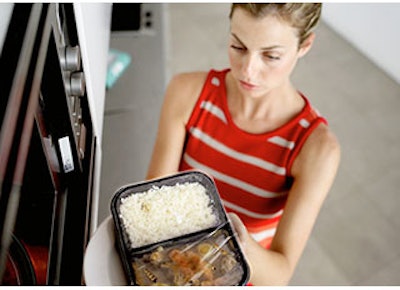
ATLANTA (PRNewswire) — Finding time to eat well doesn't mean you have to resort to eating out or going through the drive through during this busy fall season. New data analysis, supported in part by Nestle USA, indicates that people who reported dining on frozen meals ate fewer calories per day and consumed less saturated fat than those who reported eating fast food meals, also known as quick service restaurant (QSR) meals.[1] The findings also showed that those who reported eating frozen meals consumed more essential nutrients than those who reported opting for fast food meals.
The findings are based on a new analysis of data from the 2003-2010 What We Eat In America (WWEIA) National Health and Nutrition Examination Survey (NHANES), a program of the Centers for Disease Control and Prevention (CDC).
Those who Reported Dining on Frozen Meals Eat Less Calories, More Vegetables and Whole Grains
Researchers found that adults (19+ years) who reported eating frozen-food took in 253 fewer calories per day than fast food eaters and ate 25 percent more total vegetables and 61 percent more whole grains. Compared to fast food diners, those who reported eating frozen meals had a better Healthy Eating Index (HEI) score[2], ate 14 less refined grains and consumed fewer amounts of saturated and solid fats.
Frozen Meal Eaters Get More Essential Nutrients
The same study showed that those who reported eating frozen meals had higher amounts of key nutrients in their diet compared to fast food diners, including essential nutrients like:
- Fiber
- Vitamin A
- Vitamin C
- Dietary minerals like calcium, potassium and magnesium
Frozen Meals Provide Multiple Options
"Ultimately, the key to good nutrition is eating a balanced plate. Many frozen prepared meals come full of key essential nutrients, and built-in portion guidance, making them good options for those always on the go," said Chavanne Hanson, MS, RD, Wellness Champion and Head of Nutrition, Health and Wellness, Global Public Affairs for Nestle. "The fact is that frozen foods are made from many fresh ingredients and then simply frozen."
Choosing frozen meals is like delegating most of the cooking to the chefs that prepare the food fresh daily, from scratch, like those in Nestle USA's Big Kitchens. So when it comes to that weekly dinner with family or friends, think about picking up meals that were prepared using no shortcuts, such as Stouffer's® Party Size Lasagna with Meat & Sauce or Chicken Enchiladas with Cheese Sauce & Rice, eat of which feed more than 5 people and offer 3g of fiber per 280 calorie serving.
When juggling family, friends and impending holidays, consider seasonal fare with 5 grams of fiber and 300 calories or less per dish, like Apple Cranberry Chicken or Butternut Squash Ravioli by Lean Cuisine®. Both meals provide over 16 percent of the suggested daily serving of fiber.
About Nestle USA
Named one of "The World's Most Admired Food Companies" in Fortune magazine for seventeen consecutive years, Nestle provides quality brands that bring flavor to life every day. From nutritious meals with LEAN CUISINE® to baking traditions with NESTLE® TOLL HOUSE®, Nestle USA makes delicious, convenient, and nutritious food and beverages that make good living possible. That's what "Nestle. Good Food, Good Life" is all about. Nestle USA, with 2013 sales of $10 billion, is part of Nestle S.A. in Vevey, Switzerland — the world's largest food company with a commitment to Nutrition, Health & Wellness — with 2013 sales of $99 billion. For product news and information, visit Nestleusa.com or Facebook.com/NestleUSA.
The study was supported by Nestle USA. For more information and links to the Food & Nutrition Conference & Expo scientific abstracts, please visit www.andjrnl.org/article/S2212-2672(14)00786-2/abstract.



















